


xxxxxA career as a prosperous Paris stockbroker made the
Frenchman Paul Gauguin a wealthy man, but in 1883, having tired of
the trappings of civilisation, he left his job and virtually
abandoned his wife and family to devote his days to painting. In
the 1870s he had come to know and work with the leading
Impressionists - notably Pissarro
and Cézanne - and this had convinced
him that his future lay as an artist. Anxious to experience the
raw intensity of life, he first joined the artists’ colony at
Pont-Aven in Brittany. There he immersed himself in the
ancient traditions and beliefs, using a simple design and areas of
strong unnatural colours to produce works such as The
Yellow Christ and Vision after the
Sermon. It was during this period, 1888, that he spent time in the South of France with the
Dutch painter Vincent Van Gogh, two months that ended with a threat upon Gauguin’s
life. It was soon after this that he paid his two visits to the
Island of Tahiti in the South Seas. It was there, fascinated by
the traditional culture and religious beliefs of the native
people, that he produced the works for which he became famous. His
style remained simple in design, but his colours became exotic. A
well known work of this time was the vast life-cycle entitled
Where do we come from? What are we? Where are we
going?. Others included Tahitian Girl
with a Flower, The Market, The Spirit of the Dead
Watching, The White Horse, Two Tahitian Women with Mango Blossoms, and Adam and Eve. His innovative design
influenced, in particular, Expressionism, a movement which used
distortion to evoke powerful inner emotions.
PAUL GAUGUIN 1848 -
1903 (Va, Vb,
Vc, E7)
Acknowledgements
Gauguin: Self-Portrait
– Musée d’Orsay; Breton Girls Dancing – National Gallery of Art,
Washington; The Yellow Christ – Albright-Knox Gallery,
Buffalo, NY; Vision of the Sermon – National Galleries of
Scotland, Edinburgh; Van Gogh painting – Rijksmuseum Vincent van
Gogh, Amsterdam; Where do we come from, where are we, where are we
going? – Museum of Fine Arts, Boston; And the Gold of their Bodies
– Musée d’Orsay. Munch: Self-Portrait
(detail) – National Museum, Oslo; The Sick Child – National
Museum, Oslo; The Scream – National Museum, Oslo; Anxiety – Munch
Museum, Oslo; Madonna – National Museum, Oslo; Moonlight –
National Museum, Oslo; Jealousy (lithograph) – Tel Aviv Museum of
Art, Israel. Ensor: Death and the Masks
– Museum of Modern and Contemporary Art, Liège, Belgium. Redon: Head of a Martyr in a Bowl (charcoal) – Kroller-Muller
Museum, Otterlo, Netherlands. Bocklin:
Isle of the Dead – Old National Gallery, Berlin.
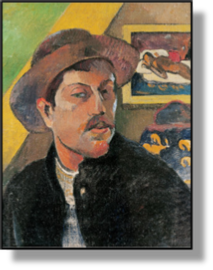 xxxxxLike his one-time friend Vincent Van Gogh, the
Frenchman Paul Gauguin was a post-impressionist painter who,
rejecting the Impressionist’s overriding aim to depict the
changing face of the natural world, used his bold, pure colours
and firm shapes to express his own deep-felt emotions,
aroused by ideas rather than appearance. As early as 1886,
therefore, he abandoned the “civilized” society of Paris - “a
desert for a poor man” as he put it - to experience the raw
intensity of life, first among the peasants of Brittany, and then,
ill and poverty stricken, among the natives of the South Pacific.
It was there, on the island of Tahiti, that he produced some of
his best and well-known works. This self-portrait was
painted in 1893.
xxxxxLike his one-time friend Vincent Van Gogh, the
Frenchman Paul Gauguin was a post-impressionist painter who,
rejecting the Impressionist’s overriding aim to depict the
changing face of the natural world, used his bold, pure colours
and firm shapes to express his own deep-felt emotions,
aroused by ideas rather than appearance. As early as 1886,
therefore, he abandoned the “civilized” society of Paris - “a
desert for a poor man” as he put it - to experience the raw
intensity of life, first among the peasants of Brittany, and then,
ill and poverty stricken, among the natives of the South Pacific.
It was there, on the island of Tahiti, that he produced some of
his best and well-known works. This self-portrait was
painted in 1893.
xxxxxGauguin was
born in Paris, but soon after his birth the family went to live in
Lima, Peru, at the home of one of his mother’s relatives. His
father having died on the outward journey, in 1855 he returned to
France with his mother and older sister Mari, and they settled in
Orleans. At the age of 17, however, anxious to see more of the
world, he went to sea, serving on a merchant vessel for the next
five years. By the time he left the service in 1871, his mother
had died and a wealthy banker, Gustav Arosa, had became his
guardian. He found him a job with a Paris stockbroker and this
launched him on a successful business career. By 1883 he had money
in the bank, a good home, a competent wife named Mette, and five
children.
xxxxxBut by this
time Gauguin, tiring of city life, had found another and more
absorbing interest - painting. He had met the leading
Impressionists - including Pissarro and Cézanne - at his
guardian’s house during the 1870s, and from then on had joined
them for painting at weekends and holidays. He had also begun
exhibiting at their shows from 1879, and had met with some, albeit
limited success. With the coming of a stock market crash in 1883,
he decided to resign his post and begin painting for a living. He
wanted to get away from the pressures of civilisation and “be free
to paint every day”. But his income from his art work proved
totally inadequate. His savings quickly ran out and matters became
worse when the family moved to Copenhagen in his wife’s native
Denmark. He struggled to find work and eventually in 1885 he
returned to Paris, taking Clovis, his six-year old son, with
him. There he worked as a bill-poster to scrape a living, but
in the harsh winter that followed Clovis almost died of smallpox
and was returned to his mother. Gauguin stayed for a short while
at Pont-Aven, an artists’ colony in Brittany, and then, fully
abandoning his family, he set off to work as a navvy on the
building of the Panama Canal. This proved another failure. He was
struck down with fever and four months later, ill and penniless,
he returned to France and Brittany.
Vc-1881-1901-Vc-1881-1901-Vc-1881-1901-Vc-1881-1901-Vc-1881-1901-Vc-1881-1901-Vc
xxxxxThe Norwegian
painter Edvard Munch
(1863-1944) lost his mother and his favourite sister early on
in his life and this affected his personality. He was morbid and
introspective by nature, and this showed in his paintings. He did
produce landscapes and genre scenes during his career - many
in the style of the Impressionists - but during the last 20
years of the 19th century in particular, his works dwelt on
sickness, death, and the anxieties and fears of a troubled mind.
His paintings in this period included By the
Deathbed, Ashes, Death
in the Sickroom, The Death Bed,
and The Dead Mother. Especially
remembered today is his The Scream of
1893, a work depicting a ghost-like figure amid swirling,
violent colours - a cry of anguish “passing through Nature”.
These bleak, innermost feelings were also to be seen in such works
as Anxiety, Madonna,
and Moonlight, contained, with many
others, in his so-called Frieze of Life.
Early on, his paintings met with derision, but later in his career
his innovative style gained recognition, and he came to be
regarded as a man of vision. The display of emotional content in
his paintings was influenced by the works of the French artists
Paul Gauguin and Vincent Van Gogh, and his distorted figures and
clash of bold colours paved the way for Expressionism, a movement
of the early 20th century.
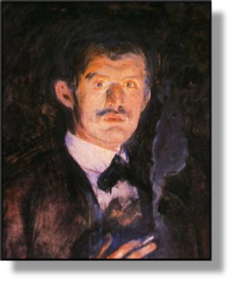 xxxxxThe Norwegian painter Edvard Munch (1863-1944)
was much influenced early in his career by the works of the French
Post-Impressionist Paul Gauguin and his fellow countryman
Vincent Van Gogh. His major paintings, belonging to the period
1892 to 1908, are characterized by their use of flat areas of
strong colour and their powerful emotional content, but many
contain, too, the exaggerated, distorted face and figures that
make him a forerunner of Expressionism. He is particularly
remembered today for his The Scream of
1893, the product of a mind in torment, and his Frieze
of Life, a series of paintings containing very personal
and, at times, disturbing images of life, love and death. (Self-portrait illustrated here.)
xxxxxThe Norwegian painter Edvard Munch (1863-1944)
was much influenced early in his career by the works of the French
Post-Impressionist Paul Gauguin and his fellow countryman
Vincent Van Gogh. His major paintings, belonging to the period
1892 to 1908, are characterized by their use of flat areas of
strong colour and their powerful emotional content, but many
contain, too, the exaggerated, distorted face and figures that
make him a forerunner of Expressionism. He is particularly
remembered today for his The Scream of
1893, the product of a mind in torment, and his Frieze
of Life, a series of paintings containing very personal
and, at times, disturbing images of life, love and death. (Self-portrait illustrated here.)
xxxxxMunch was
born in Loten in southern Norway, the second son of five children.
His father was a doctor working with the army. The family moved to
Oslo (then called Christiania) a year after his birth, and it was
there that tragedy struck. His mother died of tuberculosis when he
was five, followed by the death of his favourite sister Sophie -
also from tuberculosis - in 1877. These loses had a profound
effect upon his character. Sickly by nature and spending long
hours confined in the family apartment, he became morbid and
introverted. Of this period he later wrote, “Illness, madness and
death were the black angels that kept watch over my cradle and
accompanied me all my life”.
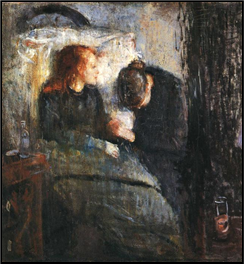 xxxxxIn 1881 he attended the State School of Art and
Crafts in Oslo, and the following year he became a member of a
small group of artists and writers, the Bohemians, bent on sexual
and artistic freedom. At this time, however, due to his retiring
nature, Munch tended to confine his work to the portrayal of
family and friends, such as Aunt Karen in the
Rocking Chair and At the Coffee Table, both of 1883, and
Family Evening, produced the following
year. In 1884, however, he won a three-week scholarship to
study in Paris and this brought him into direct contact with the
Impressionists. The influence of their works can be detected in
his first masterpiece, The Sick Child
of 1886 (here illustrated), a moving, sensitively-painted scene recalling
the death of his sister.
xxxxxIn 1881 he attended the State School of Art and
Crafts in Oslo, and the following year he became a member of a
small group of artists and writers, the Bohemians, bent on sexual
and artistic freedom. At this time, however, due to his retiring
nature, Munch tended to confine his work to the portrayal of
family and friends, such as Aunt Karen in the
Rocking Chair and At the Coffee Table, both of 1883, and
Family Evening, produced the following
year. In 1884, however, he won a three-week scholarship to
study in Paris and this brought him into direct contact with the
Impressionists. The influence of their works can be detected in
his first masterpiece, The Sick Child
of 1886 (here illustrated), a moving, sensitively-painted scene recalling
the death of his sister.
xxxxxThree years
later, following the success of his first one-man show, he
gained a state scholarship and returned to Paris, this time for
three years. It was during this stay that he came to admire in
particular the works of the post impressionists, notably Paul
Gauguin and Vincent Van Gogh, and their emotional impact had a
marked effect upon his style and subject matter. In 1891 he did
produce, amongst others, Rue Lafayette
and Promenade des Anglais, Nice,
scenes that clearly owed something to Impressionism (and
Pointillism at times), but for the most part he now discarded
reality for the creation of strong emotions centred around the
universal themes of sickness, love, anxiety, despair and death. It
was these bleak, innermost feelings that filled his own troubled
mind and needed to be expressed. His art, he explained at the
time, was “an attempt to explain to myself my relationship with
life”. In order to understand himself, there was a need to “paint
living people who breathe, feel, suffer and love” Not the
impression of reality, but the expression of his soul was what he
wanted to commit to canvas.
xxxxxAs a
consequence, over the next ten years or so - his symbolist
phase - he produced a volume of poignant but depressing works
that plumbed the depths of man’s darkest feelings: three on
melancholy, three on jealousy, and numerous scenes portraying his
obsession with sickness and death. These included By
the Deathbed, Ashes, Death
in the Sickroom, The Death Bed,
and The Dead Mother.
xxxxxAnd his
uneasy relationship with women and sex in general is obliquely
revealed in his highly charged image of Madonna,
his Puberty - the awakening of
sexual feelings -, his Three Stages of
Woman, its sequel, the enigmatic The
Dance of Life, and Man and Woman.
And to this period belongs his famous The
Scream, an anguished expression of solitude and abject
fear, created by a ghost-like, alien figure, the frantic
swirling of powerful colours, and a blood-red sky. It was a
cry, as he put it, that was “passing through Nature”.

xxxxxOther works
belonging to this period were Tahitian Girl
with a Flower, The Market, The Spirit of the Dead
Watching, The White Horse, Two Tahitian Women with Mango Blossoms, Horsemen on the Beach,
and Adam and Eve.
xxxxxGauguin
never found the tropical paradise he was after, though it did
become his spiritual home. Indeed, for much of his time in the
South Seas he was desperately unhappy, lacking money and suffering
from syphilis. At one time, in 1897, he attempted suicide by
taking arsenic, and his last years were marred by his support of
the native people in their dispute with the colonial
administration and the Catholic Church. In 1903 the authorities
sentenced him to three months’ imprisonment for what they termed
“defamation”, but he died before the result of his appeal and was
buried in Calvary Cemetery, Atuona.
xxxxxLike the
other post-impressionist painters - notably Vincent Van
Gogh and Paul Cézanne - the works of Gauguin greatly
influenced many of the trends of 20th century art. In particular,
his creation of strong emotions, “found in the depth of one’s
being”, played an important part in the development of
Expressionism, a movement noted for its use of exaggeration and
distortion to evoke powerful inner emotions. As we shall see,
among the pioneers of this movement was the Norwegian painter
Edvard Munch.

xxxxxIncidentally, when living as a prosperous stockbroker in Paris
during the 1870s and early 1880s, Gauguin spent some 17,000 francs
on buying paintings by Claude
Monet, Camille Pissarro, Auguste Renoir and other Impressionists.
……
xxxxx…… A vivid account of his life is to be found in his
journals, letters, and his autobiographical work Noa
Noa (meaning Fragrance, Fragrance),
a recording of his experiences and emotions during his first stay
in Tahiti, published in 1897. ……
xxxxx…… Inx1916 the English writer
and playwright Somerset Maugham (1874-1965) travelled to the South Seas to
obtain material for his novel The Moon and
Sixpence, a story based on the life of Paul Gauguin.
xxxxxNot
surprisingly these works caused something of a stir, both within
the artistic world and the general public. An exhibition in Berlin
in 1892, organised by the city’s Union of Artists, attracted
widespread condemnation. Within a week he was ordered to remove
his “daubs”, but this “Berlin Scandal”, as it came to be known,
brought him notoriety, and, in the long term, popularity. To take
advantage of his sudden fame, he embarked upon an extensive tour
of the major cities of Germany and Scandinavia in order to display
his “degenerate works”. As a result Munch became a household
named. For the most part his works received little approval at
this stage, but quite a large number saw purpose and merit in his
unique approach - including his fellow countryman and friend
the novelist Henrik Ibsen - and this number was destined to
grow.
xxxxxFrom the
time of this all-important exhibition to the year 1908, Munch
lived mainly in Germany. It was there in the 1890s that he
compiled his Frieze of Life, a
“symphonic arrangement” of many of his greatest paintings -
symbolic, gloomy images in which faces and figures were often
distorted, and his brushwork, thick and contorted, produced shock
waves of intense colour. These were the hallmarks of his own,
innovative style, the means by which he portrayed the darker
themes of life - misery, anxiety, fear, sickness, loneliness
and death.
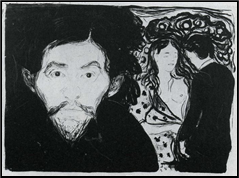 xxxxxThe turn of the century did see something of a move
away from these introspective works - with paintings like Forest, Ladies on the
Bridge and Winter Landscape,
Elgersburg, but in 1908, his emotional instability and
persecution complex, together with his heavy drinking and a
turbulent love affair, brought about a chronic nervous breakdown,
and he spent eight months in a sanatorium in Copenhagen. By then,
however, the innovative value of his work was beginning to be
recognised. In 1908 he was made a Knight of the Order of St. Olav
for his contribution to art, and enthusiasm for his paintings was
beginning to grow. In addition he was becoming highly respected
for his work as a graphic artist. In his making of etchings,
lithographs and colour woodcuts, a skill learnt in Paris in 1896,
he showed a remarkable talent, and he reproduced a number of his
major works in this new medium. Shown here is his lithograph Jealousy.
xxxxxThe turn of the century did see something of a move
away from these introspective works - with paintings like Forest, Ladies on the
Bridge and Winter Landscape,
Elgersburg, but in 1908, his emotional instability and
persecution complex, together with his heavy drinking and a
turbulent love affair, brought about a chronic nervous breakdown,
and he spent eight months in a sanatorium in Copenhagen. By then,
however, the innovative value of his work was beginning to be
recognised. In 1908 he was made a Knight of the Order of St. Olav
for his contribution to art, and enthusiasm for his paintings was
beginning to grow. In addition he was becoming highly respected
for his work as a graphic artist. In his making of etchings,
lithographs and colour woodcuts, a skill learnt in Paris in 1896,
he showed a remarkable talent, and he reproduced a number of his
major works in this new medium. Shown here is his lithograph Jealousy.
xxxxxMunch
returned to Norway in 1910 and worked there in virtual seclusion
until his death in January 1944. In the 1920s, however, large
exhibitions of his works were held in cities across Europe. By a
conscious effort, his later works were less pessimistic and, as a
result, more colourful. He produced landscapes and studies of
people working on the land, as well as a number of self portraits.
To these later years belong Workers on their
way Home, Lumberjack, Spring
Ploughing, The Haymaker, Horse Team and a number of self-portraits.
And, in addition, he produced nine murals for the Festival Hall of
Oslo University, each 15ft in height and depicting universal
force. He spent his last years at his estate at Ekely, not far
from Oslo, and it was there that he died. He left 1000 paintings
and close on 20,000 prints to the city of Oslo, and these are now
housed in the Munch Museum, purposefully built in 1963. An
isolated, troubled figure, Munch stands today as Norway’s greatest
painter and graphic artist. A man of vision at the opening of the
20th century, his haunting, distorted images captured the essence
of symbolism, and paved the way for Expressionism, a movement
marked by contorted figures, a clash of bold colours, and violent
emotion.
xxxxxIncidentally, among his
friends were several writers, including his fellow countryman and
playwright Henrik Ibsen, and the Swedish novelist August
Strindberg. He designed sets for a number of Ibsen’s plays, and
often discussed the writings of the German philosopher Friedrich
Nietzsche with Strindberg. He produced portraits of both men. ……
xxxxx…… In February 1994 four men broke into the National
Gallery in Oslo and stole its version of The
Scream, but it was recovered undamaged three months
later. Then ten years later, in August 2004, masked gunmen entered
the Munch Museum in Oslo in broad daylight and stole its version
of The Scream and Madonna
(together worth an estimated $100 million). Both works, were
recovered - slightly damaged - in August 2006.
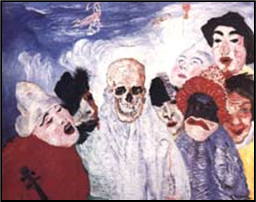
xxxxxThreexother artists
of this time are worthy of mention. The Belgian painter and
printmaker James Ensor
(1860-1949) also anticipated Expressionism. A member of Les Vingts (The Twenty),
- a group bent on developing new forms of art - his
macabre works of the 1880s and 1890s, such as Entry
of Christ into Brussels, Intrigue, and Death and the Masks (illustrated), were full of tormented figures, animated skeletons,
and grotesque phantoms and corpses. At first, as in the case of
Munch, his paintings met with derision, but in later years his
surreal works gained in popularity. Also noted for his drawings and
etchings, he spent almost his entire life in Ostend.
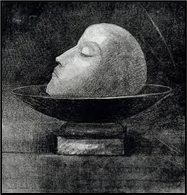 xxxxxAndxanother artist
remembered for his macabre, surreal subjects was the Frenchman Odilon Redon (1840-1916).
Produced in prints and charcoal drawings and full of strange,
frightening images, his gloomy, black and white works included The Comedy of Death, The
Crying Spider, Death: my irony
surpasses all others, and Head of a
Martyr in a Bowl (illustrated). Suchxworks
linked him with the Decadent Movement in which the artist had no limits to his or her
means of expression. However, in 1890, having met with the
Impressionists and become particularly friendly with both Paul
Gauguin and Georges Seurat, he broke with the past and began a new
career as a colourist. Working in pastels and oils, he opened the
door to life and light, producing flowers, portraits and bizarre
fantasies in bright, warm colours.
xxxxxAndxanother artist
remembered for his macabre, surreal subjects was the Frenchman Odilon Redon (1840-1916).
Produced in prints and charcoal drawings and full of strange,
frightening images, his gloomy, black and white works included The Comedy of Death, The
Crying Spider, Death: my irony
surpasses all others, and Head of a
Martyr in a Bowl (illustrated). Suchxworks
linked him with the Decadent Movement in which the artist had no limits to his or her
means of expression. However, in 1890, having met with the
Impressionists and become particularly friendly with both Paul
Gauguin and Georges Seurat, he broke with the past and began a new
career as a colourist. Working in pastels and oils, he opened the
door to life and light, producing flowers, portraits and bizarre
fantasies in bright, warm colours.
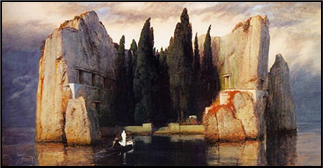
xxxxxArnoldxxBocklin (1827-1901) was
a Swiss symbolist painter. A romantic by nature, his paintings
created a weird, fantasy world where death - as in the works
of Munch - played a prominent part. He is best known today
for the five versions of his Isle of the Dead
(one illustrated here), produced between 1880 and 1886. Evoked in part by
the English Cemetery near his studio in Florence, this mysterious,
haunting painting - seen by some as a soul’s passage to the
afterlife - was to be the inspiration for a number of works,
including a symphonic poem by the Russian composer Sergei
Rachmaninoff, and a painting by the Spanish artist Salvador Dali.
xxxxxFour the
next five years he spent most of his time at Pont-Aven.
There, at the age of 40, he began to develop his own, innovative
style. Using strong, evocative colours and firmly defined flat,
bold planes, he captured on canvas not only the beauty of the
rugged countryside, but also the ancient traditions and beliefs of
the local peasants, a people as hardy as the region they
inhabited. To this period belongs (left to right) his Breton
Girls Dancing, The
Yellow Christ, an image remarkable for its vibrant,
unnatural colours and dramatic simplicity, and Vision
after the Sermon, a powerful symbolic and emotional work.
He called these decorative, almost abstract qualities “synthetic
symbolism”, the merging of a flat, simplified design with
powerful, exaggerated colours.
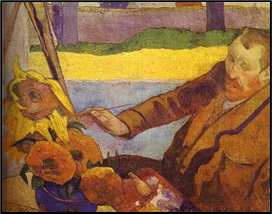 xxxxxIn October 1888, after
some hesitation, Gauguin accepted an invitation to join Vincent
Van Gogh in the South of France. He had met and worked with the
Dutch painter in 1886, and at that time had not particularly liked
him as a person nor rated him highly as a painter. However, winter
was about to begin in Brittany, and the promise of the clear skies
and warm sunshine of Province overcame his misgivings. As we have
seen, the visit, seen by Van Gogh as the beginning of an artists’
colony in the South, proved a total failure. Gauguin’s arrogance
and Van Gogh’s obstinacy made up a recipe for disaster. They were
soon quarrelling over art and life in general, heated arguments
which were fuelled by excessive drinking and rival demands for the
local prostitutes. Matters came to a head at the end of December
when Van Gogh threatened Gauguin with a razor. Gauguin hurried
back to Paris, and Van Gogh then turned the blade upon himself,
severing part of his left ear. Illustrated here is Gauguin’s
painting of Van Gogh at work on his famous Vase
of Sunflowers of 1888.
xxxxxIn October 1888, after
some hesitation, Gauguin accepted an invitation to join Vincent
Van Gogh in the South of France. He had met and worked with the
Dutch painter in 1886, and at that time had not particularly liked
him as a person nor rated him highly as a painter. However, winter
was about to begin in Brittany, and the promise of the clear skies
and warm sunshine of Province overcame his misgivings. As we have
seen, the visit, seen by Van Gogh as the beginning of an artists’
colony in the South, proved a total failure. Gauguin’s arrogance
and Van Gogh’s obstinacy made up a recipe for disaster. They were
soon quarrelling over art and life in general, heated arguments
which were fuelled by excessive drinking and rival demands for the
local prostitutes. Matters came to a head at the end of December
when Van Gogh threatened Gauguin with a razor. Gauguin hurried
back to Paris, and Van Gogh then turned the blade upon himself,
severing part of his left ear. Illustrated here is Gauguin’s
painting of Van Gogh at work on his famous Vase
of Sunflowers of 1888.
xxxxxGauguin
spent the next two and a half years working in Paris and Brittany.
He produced some promising works during this period, but he was
still short of money and he remained unsettled in mind. He
disliked “everything that is artificial and conventional”, and
yearned for the joy of a primitive life. In the Spring of 1891 he
found it in the rural area of Mataiea on the South Sea island of
Tahiti, but his paradise was short lived. His meagre savings began
to run out and this, together with ill-health, forced him to
return home. In Paris, however, he made some money from the
canvases he brought back, and this, plus a small legacy from an
uncle in Orleans, gave him sufficient funds to return to the
Tropics. He arrived back in Tahiti the summer of 1895 and over the
next eight years - the last two spent at Atuona in the
Marquesas Islands - he produced the works for which he is
most famous. Here he took a special interest in the traditional
culture and spiritual beliefs of these gentle Polynesian people.
The simplicity of design remained, but his colours became highly
exotic. One of his best known works, the life-cycle entitled
Where do we come from? What are we? Where are
we going?, has life beginning with the baby on the right
and ending with the wizened old woman on the left (illustrated below). This huge
canvas poses the questions but makes no attempt at giving the
answers. Also illustrated below is And the Gold
of Their Bodies, one of his many nude studies.


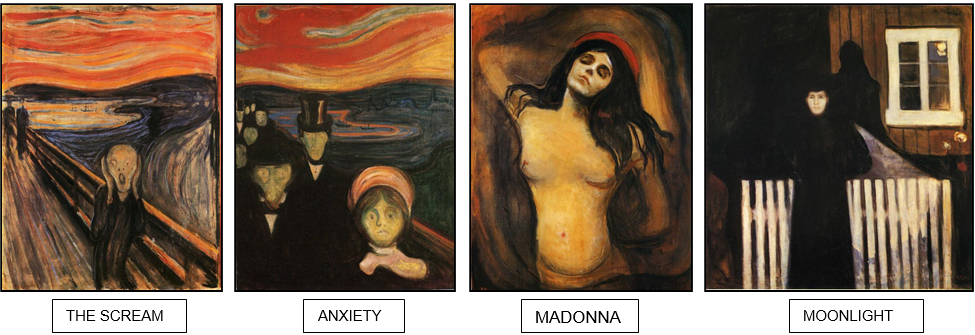






 xxxxxLike his one-
xxxxxLike his one- xxxxxThe Norwegian painter Edvard Munch (1863-
xxxxxThe Norwegian painter Edvard Munch (1863- xxxxxIn 1881 he attended the State School of Art and
Crafts in Oslo, and the following year he became a member of a
small group of artists and writers, the Bohemians, bent on sexual
and artistic freedom. At this time, however, due to his retiring
nature, Munch tended to confine his work to the portrayal of
family and friends, such as Aunt Karen in the
Rocking Chair and At the Coffee Table, both of 1883, and
Family Evening, produced the following
year. In 1884, however, he won a three-
xxxxxIn 1881 he attended the State School of Art and
Crafts in Oslo, and the following year he became a member of a
small group of artists and writers, the Bohemians, bent on sexual
and artistic freedom. At this time, however, due to his retiring
nature, Munch tended to confine his work to the portrayal of
family and friends, such as Aunt Karen in the
Rocking Chair and At the Coffee Table, both of 1883, and
Family Evening, produced the following
year. In 1884, however, he won a three-

 xxxxxThe turn of the century did see something of a move
away from these introspective works -
xxxxxThe turn of the century did see something of a move
away from these introspective works -
 xxxxxAndxanother artist
remembered for his macabre, surreal subjects was the Frenchman Odilon Redon (1840-
xxxxxAndxanother artist
remembered for his macabre, surreal subjects was the Frenchman Odilon Redon (1840-
 xxxxxIn October 1888, after
some hesitation, Gauguin accepted an invitation to join Vincent
Van Gogh in the South of France. He had met and worked with the
Dutch painter in 1886, and at that time had not particularly liked
him as a person nor rated him highly as a painter. However, winter
was about to begin in Brittany, and the promise of the clear skies
and warm sunshine of Province overcame his misgivings. As we have
seen, the visit, seen by Van Gogh as the beginning of an artists’
colony in the South, proved a total failure. Gauguin’s arrogance
and Van Gogh’s obstinacy made up a recipe for disaster. They were
soon quarrelling over art and life in general, heated arguments
which were fuelled by excessive drinking and rival demands for the
local prostitutes. Matters came to a head at the end of December
when Van Gogh threatened Gauguin with a razor. Gauguin hurried
back to Paris, and Van Gogh then turned the blade upon himself,
severing part of his left ear. Illustrated here is Gauguin’s
painting of Van Gogh at work on his famous Vase
of Sunflowers of 1888.
xxxxxIn October 1888, after
some hesitation, Gauguin accepted an invitation to join Vincent
Van Gogh in the South of France. He had met and worked with the
Dutch painter in 1886, and at that time had not particularly liked
him as a person nor rated him highly as a painter. However, winter
was about to begin in Brittany, and the promise of the clear skies
and warm sunshine of Province overcame his misgivings. As we have
seen, the visit, seen by Van Gogh as the beginning of an artists’
colony in the South, proved a total failure. Gauguin’s arrogance
and Van Gogh’s obstinacy made up a recipe for disaster. They were
soon quarrelling over art and life in general, heated arguments
which were fuelled by excessive drinking and rival demands for the
local prostitutes. Matters came to a head at the end of December
when Van Gogh threatened Gauguin with a razor. Gauguin hurried
back to Paris, and Van Gogh then turned the blade upon himself,
severing part of his left ear. Illustrated here is Gauguin’s
painting of Van Gogh at work on his famous Vase
of Sunflowers of 1888.




